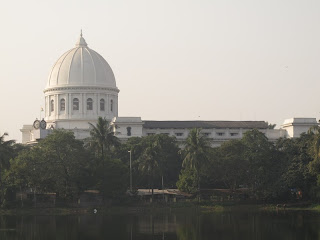As apprehensive as I was
about it (after stories of theft and such), the trip to Kolkata on
the regular sleeper wagon was uneventful. Unexpectedly, we had
problems finding a decent hotel room. After several hours of roaming
around Sudder Street and trying to free ourselves from some pesky
touts, we found a place for the night and booked another for the
remaining three. Given our traveling experience on this trip, it was
some of the most expensive accommodation while only the most basic
standards were met.
Kolkata is a former
capital of the British India, developed by merchants of the East
India Company in 1686. Now, it is India's second biggest city at
14.7 million people. It is considered its cultural center, producing
a good number of well-known intellectuals from film to science and
everything in between. The remnants of British influence are
everywhere, but nowhere are they more apparent than in the crumbing
colonial architecture of the Victorian era. It is stunning, although
it is a shame that most of the historical buildings are not up-kept
properly, as seen especially in the architecture surrounding BBD Bag.
One of the most
impressive sights is the astonishing Victoria Memorial, a museum of
Kolkata's history, dedicated to Queen Victoria of England, and the
gardens that surround it. Said to be a cross between the Taj Mahal
and the White House, its a popular spot for romantic rendez-vous.
There's also a light show at night, both in Bengali and English,
which provides a short summary of the colonial history.
Kolkata, renamed from
Calcutta in 2001 as part of the city's revitalization, is also a city
of disparities. Aside from all its splendor, it ''houses'' a big
population of the poor, so apparent in the large number of beggars on
the street as well as the shack slums as you stumble into some
neighborhoods. We went to the Mother's House, Mother Teresa's former
residence, and got a glance into her lifetime's work with the truly
destitute. Her mission still continues the work, and accepts
volunteers to help out daily.
It was also in Kolkata
that we were able to get some insight into the Indian culture,
specifically its marriage traditions. We shared a beer with a pair
of Indian men in their early 20s. When Pawel jokingly asked one of
them when he's getting married, he replied nonchalantly that probably
in 2014, after he gets the fun out of his system. The way it works
in his caste, he explained, is that his father gets about 30
propositions from families of interested “prospects”. The father
then sorts out the offers, compares family backgrounds, the women's
specifics such as health or profession, then chooses about half for
his son's review. The son then takes a look at the offers, including
the women's photographs. He then chooses about five for a meet and
greet to see with whom he's compatible. Once a candidate is chosen,
the engagement can last anywhere from a couple of days to a year.
Convenient, isn't it? Although the story should be taken with a
grain of salt, considering the man's ego or our surroundings, I do
believe he presented us with a relatively accurate picture. Of
course, everything depends on the caste.
After 5 days in Kolkata
and a bout with TD (supposedly up to 70% of travelers get it within
two weeks of arriving in India – thank God for Z-pac!), we got on
the long, 50 hour train to the south of India, a journey of
about 2,439 km. Next stop? Overnight stay in Kolam, since we
arrived late at night, and then another, this time half hour, train
ride to blissful Varkala for some much needed vacation from vacation.
And to all the eff you's right now, we love you too ;)
St. John's Church
BBD Bag
Victoria Memorial
Clean laundry
Line for those without reservations. Good luck.









I love you too :-)
ReplyDelete